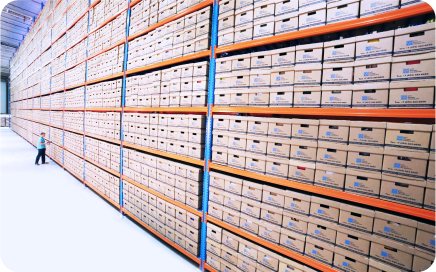Multi-Location Inventory Management: How to Stay in Control
By Rackbeat July 3, 2025

As your business grows, so does complexity
This is especially true for wholesale companies operating warehouses across different cities or even countries. Without the right setup, this can become a logistical nightmare. But with the right strategy and a modern inventory management system, you can handle multi-location logistics with ease — and without the headaches.
In this article, we cover:
Why multi-location inventory management quickly becomes complex
How a WMS and digital system provide real-time clarity
How to optimize purchasing and avoid over- or understocking
How to stay on top of orders across locations
What to look for in a system that can scale with your business
Whether you’re already juggling multiple warehouses — or planning to expand — this is your practical guide to stabilizing your logistics and fueling your growth.
Why is multi-location inventory management so challenging?
On paper, it sounds simple: more warehouses just mean more coordination. But in reality, complexity grows exponentially with each new location — especially if your systems aren’t connected or your processes aren’t designed for a multi-site setup.
Here are some of the most common challenges businesses face:
Double bookings and inaccurate stock levels
If your systems aren’t integrated — or you’re still managing inventory in spreadsheets — it’s hard to track what’s stored where. That can result in stock discrepancies or accidentally selling the same item twice without being able to fulfill the order.Order handling bottlenecks
When staff don’t know which items are in which location, valuable time is lost — either searching for items or rerouting orders manually. This slows down your entire operation and increases the risk of errors.Incorrect and unnecessary purchasing
Without a clear overview, you may reorder products for one warehouse while they sit unused in another. That ties up capital, wastes space, and creates inefficiencies where goods are needed most.Slow and inefficient order fulfillment
If orders aren’t dispatched from the most optimal location — e.g. the one closest to the customer or with the best capacity — you’ll waste time and shipping costs, and potentially hurt the customer experience.
Without a digital system coordinating all locations in real time, chaos can quickly take over — and that can cost you customers, revenue, and control.
The Key: A WMS with Location Management
If you want to scale without losing control, the most effective solution is implementing a modern Warehouse Management System (WMS) with built-in multi-location functionality. This provides not just structure, but a competitive edge in today’s complex logistics landscape.
A dedicated inventory system with location control allows you to:
Set up and manage multiple warehouses in one unified system
Easily add new locations, split existing ones into zones or sections, and adjust as needed — all while keeping a clear overview.Access real-time stock levels across all locations
Whether you’re at headquarters or a satellite site, you’ll always know what’s in stock and where, without needing manual updates or guesswork.Automatically route orders based on proximity, stock levels, or priority
The system chooses the most efficient fulfillment route — saving time and reducing shipping costs, while improving profitability.Strengthen collaboration between warehouse staff and purchasing teams
When everyone works from the same system and data, misunderstandings are avoided and inventory decisions become more accurate.
With the right location setup, you can scale operations, respond faster, and serve smarter — without losing control.
Smarter Purchasing with Multi-Location Setup
When all your warehouses are connected in one system, purchasing becomes more precise and efficient. You gain a clear view of what needs to be ordered, for which location — and when.
This leads to:
Less overstock and fewer stockouts
Reorder reminders based on real-time stock data across all locations
More efficient order grouping for suppliers — even when deliveries go to multiple warehouses
Keep Orders Flowing Without the Chaos
Having stock is one thing. Being able to deliver it from the right location is another.
A warehouse system with multi-location order control can:
Automatically select the most efficient warehouse for picking and shipping
Split orders across locations if needed
Provide your sales team and customer service with full visibility into order status and delivery timelines
This means faster, more accurate support — and smoother internal workflows.
Scaling Without Complexity: Easy Location Setup
Many assume that multi-location inventory control requires complex setup. But it doesn’t have to. With the right system architecture, you can easily create new locations — whether it’s a pop-up shop, a new central warehouse, or a temporary storage space.
That way, your system supports your growth — rather than getting in the way of it.
Conclusion: Multi-Location Inventory Management is a Competitive Advantage
If you want to avoid chaos, mispicks, and wasted resources, then managing inventory across multiple locations is essential. The right solution shouldn’t just offer visibility — it should actively help you:
Streamline your order handling
Improve purchasing control
Unlock the full potential of a modern WMS
Scale your operations without losing track
With the right inventory system, multi-location management isn’t just possible — it’s actually easy.
Ready to take control of your warehouses?
Whether you manage two or twenty locations, one thing is certain: the better your overview, the faster you can deliver, the more accurately you can purchase, and the more effectively you can run your operations.
Multi-location inventory management doesn’t have to be complex — it just requires the right system and the right know-how.
Want more tips, guides, and inspiration for smarter inventory management?
Sign up for our newsletter and receive regular insights on optimizing your operations — including location control, WMS, purchasing, and order handling — straight to your inbox.



